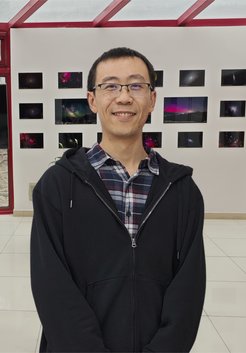Bridging Continents, Advancing Science
Jinyi Shangguan leads new Max Planck Partner Group with China to study the growth of supermassive black holes.
The Max Planck Institute for Extraterrestrial Physics (MPE) and the Kavli Institute for Astronomy and Astrophysics (KIAA) at Peking University are launching a Max Planck Partner Group led by Dr. Jinyi Shangguan to study supermassive black hole evolution using GRAVITY+ on the Very Large Telescope Interferometer. This collaboration will refine black hole mass measurements, develop advanced data analysis techniques, and strengthen scientific exchange between Germany and China.

The new partnership is set to leverage the GRAVITY+ instrument on the Very Large Telescope Interferometer to conduct high-resolution, multiwavelength observations of active galactic nuclei across a wide range of redshifts. The project aims to achieve unprecedented precision in measuring supermassive black hole masses, mapping the structure of the broad-line region, investigating the physics of accretion, and exploring the coevolution of black holes and their host galaxies. This is also one of the main primary scientific topics for the Infrared Group at MPE, led by Prof. Reinhard Genzel and Prof. Frank Eisenhauer. “This is a prime example of our strategy to build novel instruments and use them to tackle key scientific questions”, says Prof. Eisenhauer, who led the development of GRAVITY+.
At a time when questions surrounding the early growth of supermassive black holes and their role in galaxy evolution are more pressing than ever, this partner group is poised to make significant contributions to the field. The collaborative framework will not only enhance observational capabilities but also stimulate the development of innovative data analysis and modeling techniques incorporating comprehensive multiwavelength observations essential for the next generation of astrophysical discoveries.
“Our goal is to push the boundaries of what we know about supermassive black holes. We hope not only to refine measurements of black hole masses but also to uncover the intricate links between black holes and the galaxies that harbor them“, says Dr. Shangguan. His vision includes the development of novel techniques for interferometric data analysis and a strong emphasis on training the next generation of astronomers through active student and postdoctoral exchange programs between MPE and KIAA.
Advancing Global Collaboration in Black Hole Research

Building on a legacy of excellence established by earlier partner groups, this new initiative will foster a dynamic, collaborative network between researchers in Germany and China. Regular visits, remote meetings, and dedicated workshops on NIR interferometry and black hole science between students, postdocs, and professors from both institutes are among the planned activities to ensure seamless integration and mutual exchange of expertise.
China was the starting point of the Max Planck Partner Group scheme and remains a focus at 17 of more than 80 groups worldwide. Partner Groups can be set up with an institute abroad provided that, following a research residency at a Max Planck Institute, outstanding early career researchers (postdocs) return to a high-capacity, well-equipped laboratory in their home country and carry out further research on a subject that is also of interest to their previous host Max Planck Institute.













